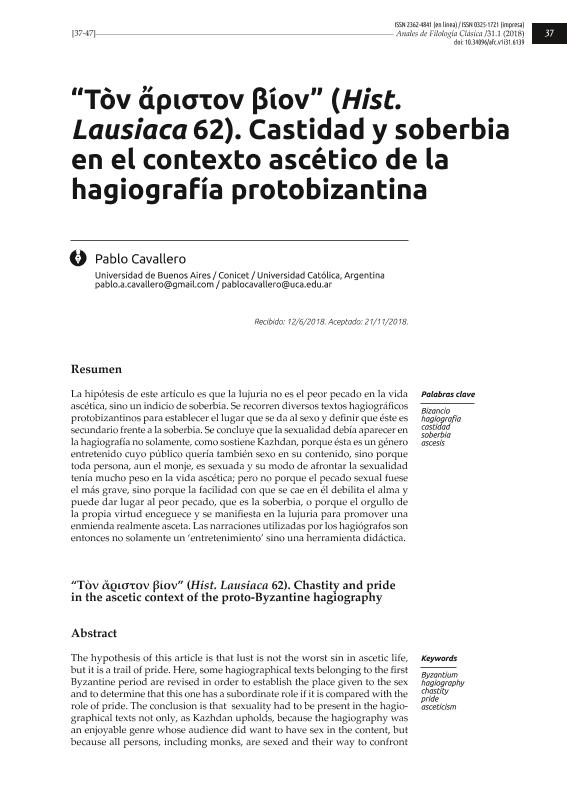Mostrar el registro sencillo del ítem
dc.contributor.author
Cavallero, Pablo Adrian

dc.date.available
2021-01-28T20:55:35Z
dc.date.issued
2019-05-23
dc.identifier.citation
Cavallero, Pablo Adrian; Τὸν ἄριστον βιοι” (Hist. Lausiaca 62). Castidad y soberbia en el contexto ascético de la hagiografía protobizantina; Universidad de Buenos Aires. Facultad de Filosofía y letras. Instituto de Filología clásica; Anales de Filología Clásica; 1; 31; 23-5-2019; 37-47
dc.identifier.uri
http://hdl.handle.net/11336/124083
dc.description.abstract
La hipótesis de este artículo es que la lujuria no es el peor pecado en la vida ascética, sino un indicio de soberbia. Se recorren diversos textos hagiográficos protobizantinos para establecer el lugar que se da al sexo y definir que éste es secundario frente a la soberbia. Se concluye que la sexualidad debía aparecer en la hagiografía no solamente, como sostiene Kazhdan, porque ésta es un género entretenido cuyo público quería también sexo en su contenido, sino porque toda persona, aun el monje, es sexuada y su modo de afrontar la sexualidad tenía mucho peso en la vida ascética; pero no porque el pecado sexual fuese el más grave, sino porque la facilidad con que se cae en él debilita el alma y puede dar lugar al peor pecado, que es la soberbia, o porque el orgullo de la propia virtud enceguece y se manifiesta en la lujuria para promover una enmienda realmente asceta. Las narraciones utilizadas por los hagiógrafos son entonces no solamente un ‘entretenimiento’ sino una herramienta didáctica.
dc.description.abstract
The hypothesis of this article is that lust is not the worst sin in ascetic life, but it is a trail of pride. Here, some hagiographical texts belonging to the first Byzantine period are revised in order to establish the place given to the sex and to determine that this one has a subordinate role if it is compared with the role of pride. The conclusion is that sexuality had to be present in the hagiographical texts not only, as Kazhdan upholds, because the hagiography was an enjoyable genre whose audience did want to have sex in the content, but because all persons, including monks, are sexed and their way to confront the sexuality had a prevalent importance in ascetic life; but not because the sexual sin were the most serious, but because the ease to fall in it weakens the soul and it gives rise to the worst of the sins, the pride; or because the man’s arrogance about his own virtue blinds him and becomes evident in the lust, in order to promote a really ascetic amendment. Then, the stories which are told by the hagiographers are not only an ‘entertainment’ but a didactic tool.
dc.format
application/pdf
dc.language.iso
spa
dc.publisher
Universidad de Buenos Aires. Facultad de Filosofía y letras. Instituto de Filología clásica
dc.rights
info:eu-repo/semantics/openAccess
dc.rights.uri
https://creativecommons.org/licenses/by-sa/2.5/ar/
dc.subject
BIZANCIO
dc.subject
HAGIOGRAFÍA
dc.subject
SEXO
dc.subject
CASTIDAD
dc.subject
ASCESIS
dc.subject
SOBERBIA
dc.subject.classification
Otras Lengua y Literatura

dc.subject.classification
Lengua y Literatura

dc.subject.classification
HUMANIDADES

dc.title
Τὸν ἄριστον βιοι” (Hist. Lausiaca 62). Castidad y soberbia en el contexto ascético de la hagiografía protobizantina
dc.title
“Τὸν ἄριστον βίον” (Hist. Lausiaca 62). Chastity and pride in the ascetic context of the proto-Byzantine hagiography
dc.type
info:eu-repo/semantics/article
dc.type
info:ar-repo/semantics/artículo
dc.type
info:eu-repo/semantics/publishedVersion
dc.date.updated
2021-01-27T19:16:25Z
dc.identifier.eissn
2362-4841
dc.journal.volume
1
dc.journal.number
31
dc.journal.pagination
37-47
dc.journal.pais
Argentina

dc.journal.ciudad
Buenos Aires
dc.description.fil
Fil: Cavallero, Pablo Adrian. Universidad de Buenos Aires; Argentina. Pontificia Universidad Católica Argentina "Santa María de los Buenos Aires"; Argentina. Consejo Nacional de Investigaciones Científicas y Técnicas; Argentina
dc.journal.title
Anales de Filología Clásica
dc.relation.alternativeid
info:eu-repo/semantics/altIdentifier/url/http://revistascientificas.filo.uba.ar/index.php/afc/article/view/6139
dc.relation.alternativeid
info:eu-repo/semantics/altIdentifier/doi/https://doi.org/10.34096/afc.v1i31.6139
Archivos asociados
